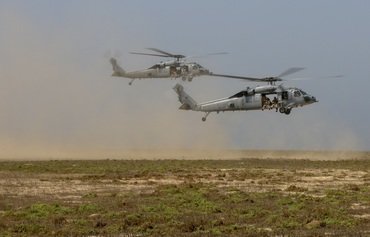The US Marines Corps (USMC) is specifically designed to work with the US Navy to seize adversary naval bases ahead of military land campaigns.
This capability has become particularly relevant following recent attempts by Iran to seize commercial ships in the Gulf, and the US military's response by sending increased military assets into the region, including the deployment of two amphibious ships and thousands of US Marines.
Title 10 of the United States Code, which outlines the role of US armed forces, provides the legal basis for the roles, missions and organisation of each of the services.
Under Subtitle C, it deems that "the Marine Corps shall be organised, trained, and equipped to provide fleet marine forces of combined arms, together with supporting air components, for service with the fleet in the seizure or defense of advanced naval bases and for the conduct of such land operations as may be essential to the prosecution of a naval campaign."
![US Marines set security while conducting a fast-rope insertion from a UH-1Y Venom during a visit, board, search and seizure training aboard the amphibious assault ship USS Bataan in the Atlantic Ocean July 19. Fast-roping is a tactical maneuver used to quickly insert troops into austere terrain in which a helicopter may not be able to land. [US Marine Corps]](/cnmi_am/images/2023/08/02/43314-230719-m-vp565-2295-600_384.jpg)
US Marines set security while conducting a fast-rope insertion from a UH-1Y Venom during a visit, board, search and seizure training aboard the amphibious assault ship USS Bataan in the Atlantic Ocean July 19. Fast-roping is a tactical maneuver used to quickly insert troops into austere terrain in which a helicopter may not be able to land. [US Marine Corps]
After US Marines have secured a naval base and the surrounding area, doctrine suggests they then "penetrate inland, gain a beach head, spread farther and farther, until the offshore waters are made secure and space is gained for consolidation of forces and their organization for the main attack", according to an article in Proceedings by the US Naval Institute.
The USMC's organisation enables it to fulfil its critical military role as an amphibious warfare force.
The basic structure for all deployed USMC units is a Marine Air-Ground Task Force (MAGTF), which includes a ground combat element, an aviation combat element and a logistics combat element under a common command element.
The size of a MAGTF depends on its mission, but its structure never varies.
It can operate either alone or as part of a coalition.
There are four types of MAGTFs: the Marine Expeditionary Force (MEF), the Marine Expeditionary Brigade (MEB), the Marine Expeditionary Unit (MEU) and the Special Purpose MAGTF.
The MEF, the largest of the types, is the main warfighting organisation during larger crises or contingencies.
As the United States' premier crisis response force, the USMC can rapidly deploy a combined-arms task force to almost anywhere in the world within days.
The US Navy provides transport, logistical and combat support to the USMC to get it where it needs to go, such as maritime prepositioning ships and naval gunfire support.
Expeditionary force-in-readiness
Whether responding to natural disasters or regional aggression, the USMC and the Navy provide self-contained and self-sustained air, land and sea strike forces, operating from a protected sea base, that can be tailored to meet any contingency.
The USMC describes itself as an "expeditionary force-in-readiness" that is manned, trained and equipped specifically to respond quickly to a broad variety of crises and conflicts and "assure littoral access".
For light transport and attack capabilities, the USMC uses the Bell UH-1Y Venom and Bell AH-1Z Viper helicopters.
The MV-22 Osprey tiltrotor provide medium-lift capabilities, while the CH-53E Super Stallion and the newer CH-53K King Stallion provide heavy-lift capabilities.
For rapid mobility, the USMC uses the LAV-25, a dedicated wheeled armored personnel carrier with amphibious capability.
It also utilises the AAV-7A1 Assault Amphibious Vehicle, which is due to be replaced by the Amphibious Combat Vehicle, a faster vehicle with superior armor and weaponry.

![A US Marine Corps officer watches an Osprey aircraft land on July 6 during a training exercise.[US Marine Corps]](/cnmi_am/images/2023/08/02/43313-230706-m-ra094-1049-600_384.jpg)






